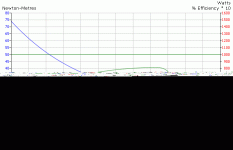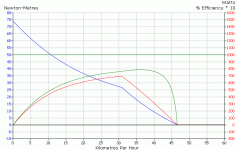10 kW
Thanks for the reply.
I only know a little about motors and power, but do tinker quite a bit with various things. I am working with students with very little practical experience (as much of a paradox as it might seem, such is the current nature of the majority of even engineering students). The "K" value is obvious and I suspect easily available from a manufacturer. A few questions about other parameters:
1) Is measuring the "motor resistance" as simple as putting a meter across the windings? I am working with a group of students writing a proposal to fund the building of an electric vehicle and we don't currently have any motors to test. I know only the very basics of brushless motors, but I understand there are multiple windings and that the motor is made to rotate by cycling the current through the windings, which is timed by sensors in the motor to determine where the rotor and stator are relative to each other. So what resistance is relevant? They are, presumably, in parallel to each other but only one is active at a time so I am assuming the resistance of a single winding is the relevant resistance.
2) Same basic questions about no-load current. Do you simply run the motor through an ampmeter or a clamp meter and check the current through one set of windings? Would this not vary with the voltage applied if the resistance is fixed?
3) Is a manufacturer likely to communicate this information?
A 10% good number for speed and power required are more than sufficient. Actually, that degree of accuracy would be highly unusual with such an easy-to-use simulator in my line of work (chem. eng. reserach) and would be highly welcomed.
The reason for these questions is that we don't have a large budget and don't want to do a lot of costly experimentation with different motors, so the simulator will be a primary tool for limiting motor choices. If motors are rated by the vendor in terms of power, it is probably a highly subjective measurement since one has no idea how the number was determined and if it is max power, continuous, etc. If we could boil the motor parameters down to a small set of quantifiable values like those required by the simulator, we could at least see at what conditions the power ratings are reached and then make a judgement about if a motor from a particular vendor is likely to run continuously at that power or if not, try to judge for how long the motor might stand up to it. We are building a vehicle for a hilly area and while the distance for which the vehicle is being designed is not long, it is a series of hills and not a flat drive. Because our budget is limited we want to make an appropriate choice. In particular, the students seem excited about the offerings by Golden Motor, esp. the heralded "MP"; GM sells motors rated at 1000W at 48V much cheaper than about any other vendor I have seen, but I don't know what that power rating means. As we expect to need on the order of 1500W peak for times on the order of a minute, if that figure is continuous, that is probably fine. If it is peak power or close to it, it will not work. Now I know there is a good deal of positive and negative sentiment on this board with respect to GM, but if we had some objective numbers that quantify the motor design, we could judge for ourselves what to expect. Some of their larger motor designs have some potentially useful characteristics for us so we don't want to eliminate their products out of hand based only on negative PR. However, we do need to be mindful of "due diligence" and do what work we can up front to be sure our selections are likely to be approproiate choices.
Thanks for any help.
I only know a little about motors and power, but do tinker quite a bit with various things. I am working with students with very little practical experience (as much of a paradox as it might seem, such is the current nature of the majority of even engineering students). The "K" value is obvious and I suspect easily available from a manufacturer. A few questions about other parameters:
1) Is measuring the "motor resistance" as simple as putting a meter across the windings? I am working with a group of students writing a proposal to fund the building of an electric vehicle and we don't currently have any motors to test. I know only the very basics of brushless motors, but I understand there are multiple windings and that the motor is made to rotate by cycling the current through the windings, which is timed by sensors in the motor to determine where the rotor and stator are relative to each other. So what resistance is relevant? They are, presumably, in parallel to each other but only one is active at a time so I am assuming the resistance of a single winding is the relevant resistance.
2) Same basic questions about no-load current. Do you simply run the motor through an ampmeter or a clamp meter and check the current through one set of windings? Would this not vary with the voltage applied if the resistance is fixed?
3) Is a manufacturer likely to communicate this information?
A 10% good number for speed and power required are more than sufficient. Actually, that degree of accuracy would be highly unusual with such an easy-to-use simulator in my line of work (chem. eng. reserach) and would be highly welcomed.
The reason for these questions is that we don't have a large budget and don't want to do a lot of costly experimentation with different motors, so the simulator will be a primary tool for limiting motor choices. If motors are rated by the vendor in terms of power, it is probably a highly subjective measurement since one has no idea how the number was determined and if it is max power, continuous, etc. If we could boil the motor parameters down to a small set of quantifiable values like those required by the simulator, we could at least see at what conditions the power ratings are reached and then make a judgement about if a motor from a particular vendor is likely to run continuously at that power or if not, try to judge for how long the motor might stand up to it. We are building a vehicle for a hilly area and while the distance for which the vehicle is being designed is not long, it is a series of hills and not a flat drive. Because our budget is limited we want to make an appropriate choice. In particular, the students seem excited about the offerings by Golden Motor, esp. the heralded "MP"; GM sells motors rated at 1000W at 48V much cheaper than about any other vendor I have seen, but I don't know what that power rating means. As we expect to need on the order of 1500W peak for times on the order of a minute, if that figure is continuous, that is probably fine. If it is peak power or close to it, it will not work. Now I know there is a good deal of positive and negative sentiment on this board with respect to GM, but if we had some objective numbers that quantify the motor design, we could judge for ourselves what to expect. Some of their larger motor designs have some potentially useful characteristics for us so we don't want to eliminate their products out of hand based only on negative PR. However, we do need to be mindful of "due diligence" and do what work we can up front to be sure our selections are likely to be approproiate choices.
Thanks for any help.



